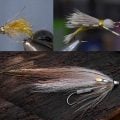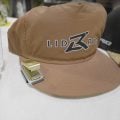How to Tie a Franke Shiner
Producer: Tim Flagler
The Franke Shiner by Floyd Franke, one of the founders of the Catskill Fly Tyers Guild, is a favorite streamer of mine. Since I started doing Trout Spey, I’ve come to like it even more.
When tying the Franke Shiner and other similar streamers, a rotary vise makes the job much, much easier, especially when used in conjunction with an adjustable bobbin cradle. For a hook, I’m going to go with a Mustad 3665A, but any streamer hook in the 6-8X long range and in sizes 4-10 will work just fine. Begin by getting the hook firmly secured in the jaws of your tying vise. If you’re using a rotary vise, check to make sure the shank is roughly in line with the axis of rotation.
Load a bobbin with a spool of white UNI-Stretch, it will be used to create the underbody of the fly. Get the UNI-Stretch started on the hook shank, leaving a little space behind the eye, and take a half dozen or so wraps rearward before snipping off the excess tag.
Large, opal-colored Mirage Tinsel is used to create the overbody of the fly. A 12” length is enough to make a couple of Shiners. Lay one end of the tinsel against the near side of the hook and take wraps with the Uni-Stretch to secure it. Use a materials clip or here, a magnet, to hold the tinsel back and out of the way on your tying vise.
Now, for some rotary vise magic. Simply hold the stretch material at a slight angle rearward and begin rotating your vise to create the underbody of the fly. Be careful when you get back toward the hook point, where it’s better to wrap by hand to avoid cutting or fraying the material. When you reach the point, begin making touching turns with the Uni-Stretch back up the hook shank. Giving your bobbin a counterclockwise spin every so often will help to keep the UNI-Stretch nice and flat. Continue making wraps and uncording your thread periodically, all the way up the hook shank, until the UNI-Stretch hangs about 2 eye-lengths behind the back edge of the hook eye. Swing the bobbin cradle into position and hang your thread over top of it.
Get hold of the tinsel and bring it around the far side of the hook in the regular direction of thread wrap. While holding it at an angle, begin turning the vise to produce slightly overlapping wraps up the hook shank. When you reach the UNI-Stretch, use it to anchor the tinsel then snip the excess off close. Take a few more wraps to cover up the tinsel’s end. Then, reach for your whip finish tool and use it to perform a 3 turn, back to front, whip finish. Seat the knot well and snip the UNI-Stretch off close. The white underbody really makes the tinsel pop.
I like to use clear Sally Hansen’s Hard as Nails to reinforce the body of the fly. Just make sure to wipe nearly all of the liquid from the entire brush before applying it to the wraps. You really only need the smallest amount. Here again, a rotary vise makes applying a thin, even coat an absolute breeze. You do need to set the fly aside to allow the Sally Hansen’s to dry completely. Once dried, reinsert the hook into the jaws of your tying vise.
For thread, olive UTC 140 Denier is a good choice. In smaller sizes, say 8’s and 10’s, I’ll drop down to 70 Denier in order to keep bulk at the head of the fly to a minimum. Start the olive thread on the hook shank, behind the hook eye, and take a half dozen or so wraps rearward before snipping off the excess tag.
I like to tie in the material on the underside of the fly first, so rotate the hook into an inverted position. Three different colors of bucktail are used on the fly – light olive and a darker brown olive for the wing, and natural white for the belly. I like to clean and stack small clumps of each prior to the start of tie-in. The white bucktail for the belly gets tied in first. Place the tips well into the hook gap then, using the back edge of the eye as a guide for your scissors, snip the butt ends off square. Give your bobbin a little counterclockwise spin, so the first thread wrap will want to jump rearward to catch the very ends of the bucktail. Take forward wraps of tying thread to firmly anchor the bucktail to the hook shank, ending with your thread at the rear end of the wraps.
Silver Dr. Blue saddle hackle fibers are used for the fly’s throat. Preen a dozen or so fibers down, perpendicular to the stem, and pull the stem away to strip them free. With the fiber’s tips pointing to the rear of the fly, lay them on top of the white bucktail, so the tips extend halfway down the bucktail. Here again, use the back edge of the hook eye as a guide for your scissors, and snip the butt ends off square. Spin your bobbin counterclockwise then anchor the fibers with nice tight thread wraps. Flip the fly back over to its normal position in preparation for tying in the wing. Your thread should be located at the front end of the throat.
Get hold of the lighter olive clump of bucktail and measure to form a wing that extends just beyond the bend of the hook. Lay the clump on top of the hook shank. This time, simply take nice tight thread wraps to secure the hair. Gently lift the butt ends up and, using the angle of the hook eye as a guide, snip them off at a shallow angle. This will help when it comes to producing a good-looking head on the fly. Position your tying thread at the back edge of the thread wraps.
Now, snip a half dozen or so strands of olive Krystal Flash free from the hank and lay them on top of the wing, even with its tips. Again, use thread wraps to secure it then lift the excess up and snip it off close.
An extremely small drop of super glue, here Fly Tyers Z-Ment, applied to the thread wraps at this point will help ensure none of the materials, tied in thus far, will pull free. Take tight, rearward wraps of tying thread to set the adhesive and really lock things down.
The darker olive brown bucktail is the last material to be tied in. Align its tips with those of the underwing, and take wraps of tying thread to anchor the hair. Just as before, lift the butt ends up and snip them off at a shallow angle. Take wraps of tying thread to build up a smooth head on the fly. Wrapping from front to back will help to keep the thread wraps from slipping down and becoming loose. End with your thread at the back edge of the wraps. Reach for your whip finish tool and use it to do a 5-6 turn, back to front whip finish, then seat the knot well and snip or cut your tying thread free.
Take another small amount of the clear Sally Hansen’s and apply it to the bare thread wraps. We’re going to put eyes on this fly, and having a well-sealed head is critical for achieving a good result. Be sure to check that none of the adhesive has run down into the hook eye. Set the fly aside in a safe place and give the Sally Hansen’s an ample time to dry.
I’m going to use both yellow and black nail polish to create the eyes of the fly. Yes, the girls behind the make-up counter at the local drug store know me well. I hear their whispers and I pretend it doesn’t hurt. Pick up the yellow polish first and place an ample drop onto a scrap piece of paper. I use bamboo skewers with their tips sanded down to different diameters, to help me create relatively equal-sized eyes on either side of the fly. First, pick up the wider-tipped skewer and dab it into the yellow nail polish. You don’t need much. An upside-down glass works nicely for bracing shaky, well-caffinated hands.
While blocking the view with your thumb, create a nice yellow circular dot on the near side of the fly, then flip it around and do the same on the far side. If you don’t get full coverage, you can always go back and retrieve a little more yellow polish. Here again, it’s extremely important to set the fly aside in a safe place and allow it to dry thoroughly before moving on to the next step.
With the yellow completely dry, place a small amount of the black nail polish onto the scrap piece of paper. With the smaller tipped bamboo skewer, pick up just a minuscule amount of the polish. Carefully place a drop in the center of the yellow, first on the near side, and then on the far side of the fly. Again, if you don’t get full coverage, don’t be afraid to go back and retrieve a little more polish to get it right. By now, I think you know what I’m going to say. Set the fly aside and allow the eyes to completely dry, before moving on.
Once the eyes are totally dry, pick up just a minimal amount of the clear Sally Hansen’s and use it to apply a light coat over the entire head of the fly. This will help to protect the eyes and add some luster and shine. As before, it’s a good idea to check and make sure the eye isn’t get blocked with adhesive.
And that’s Floyd Franke’s Shiner. It’s a dynamite streamer pattern, particularly for you trout spey swingers.
How to Tie a France Fly
How to Tie a Free-Swimming Caddis Larva











